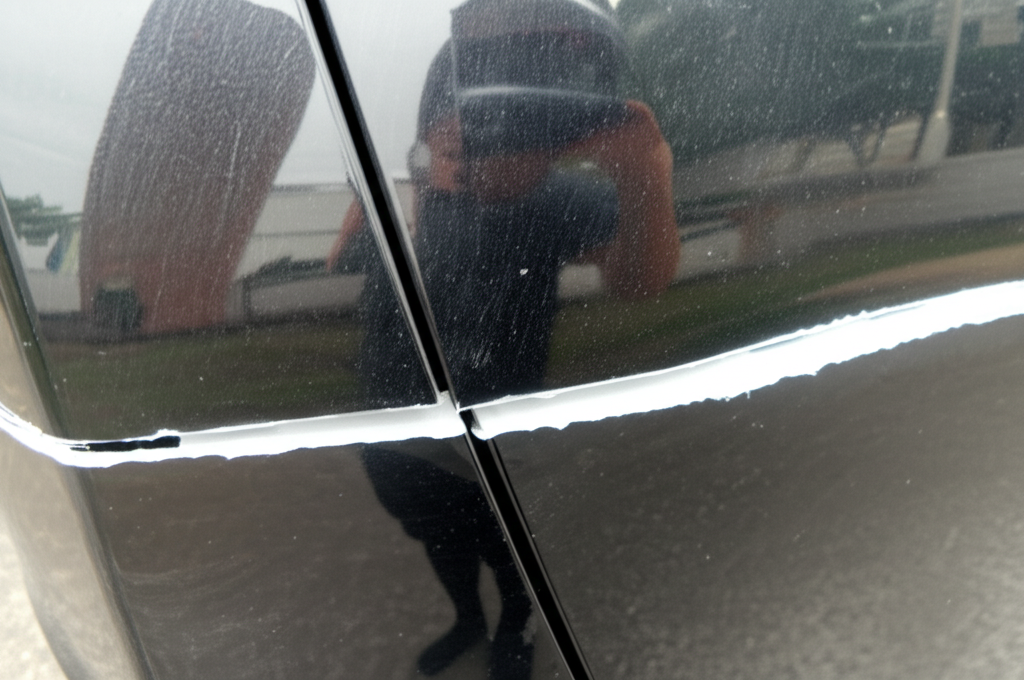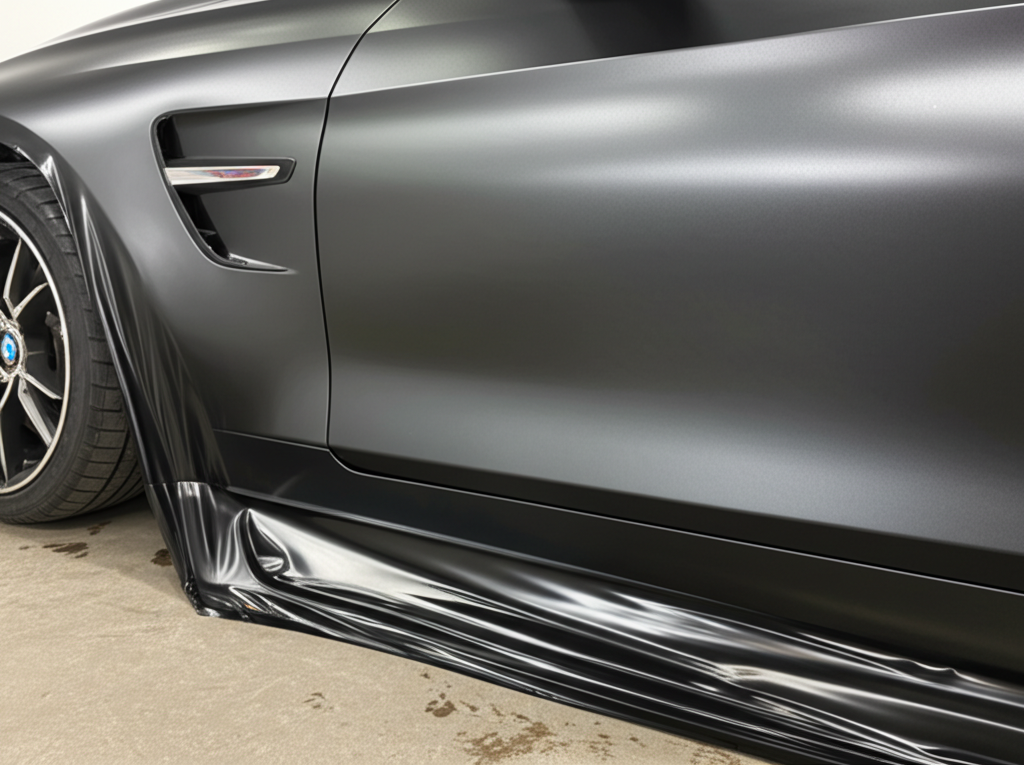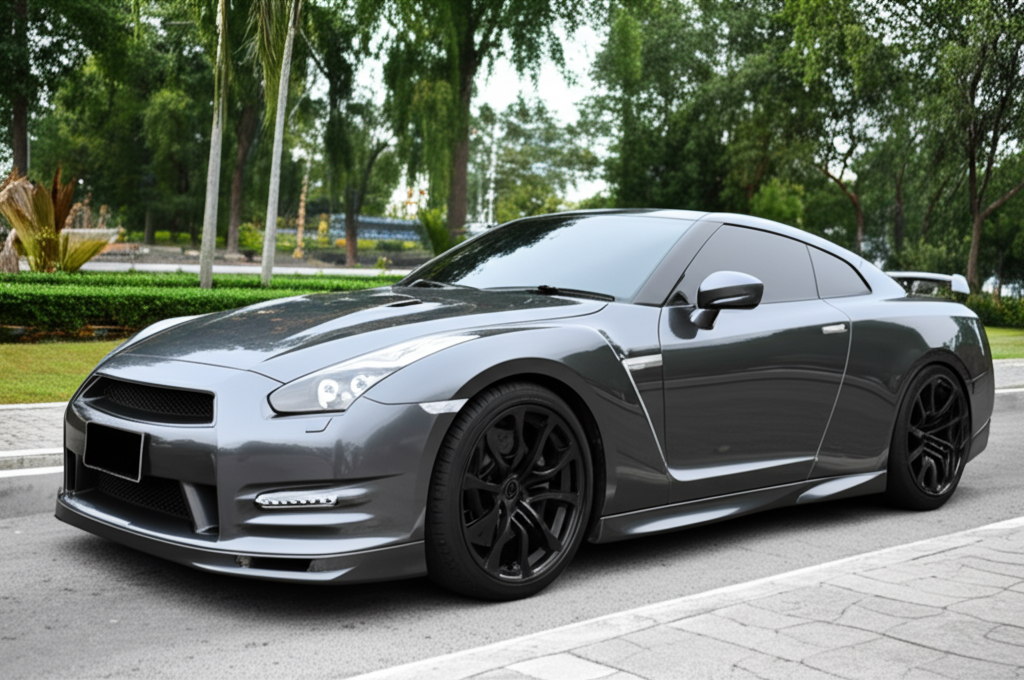You take immense pride in your vehicle. It’s more than just transport; it’s a statement, an extension of your personality on the vibrant roads of Thailand. You meticulously maintain its performance and appearance. So, when you decide to personalize it further with a car wrap, you expect nothing less than perfection. You envision a flawless finish, vibrant colour, and sharp lines. But what happens when, just weeks or months later, you spot those dreaded signs – the corners lifting, the edges peeling back, revealing the paint underneath? It’s frustrating, isn’t it? It undermines the entire aesthetic and makes you question the investment. How can you ensure the wrap you choose not only looks stunning initially but *stays* stunning, especially around those challenging edges and curves?

Meet Mr. Chatri, a Bangkok-based architect known for his keen eye for detail, driving a meticulously maintained BMW 5 Series. Wanting a unique satin grey finish, he initially opted for a seemingly budget-friendly wrap service he found online. The initial result looked acceptable from a distance, but his discerning eye soon caught imperfections. Within three months, particularly after navigating Bangkok’s heat and rainy season, the wrap started failing at the door handle recesses, mirror caps, and bumper edges. “It was disappointing,” Mr. Chatri recalls. “The peeling edges made the whole car look cheap, completely defeating the purpose of the wrap. It felt like I’d wasted my money.”
Determined to get it right, Mr. Chatri researched specialist installers known for their precision work. He chose a reputable workshop that emphasized their edge-finishing techniques. The process was markedly different. The technicians spent significantly more time on surface preparation, ensuring every panel was clinically clean. They carefully removed trim pieces like door handles and badges where necessary, allowing them to wrap the vinyl *around* edges rather than just trimming *to* them. He watched as they used specialized tools to tuck the film deep into panel gaps and meticulously post-heated every edge and curve. This critical step relaxes the vinyl’s ‘memory’, significantly reducing the chance of it shrinking back and lifting. The transformation was remarkable. The new satin grey wrap flowed seamlessly over every contour. The edges were invisible, tucked away securely. “The difference is night and day,” Mr. Chatri beams. “Months later, even with daily driving and regular washing, every edge is still perfect. It’s this level of detail that defines true quality. This is the finish I originally envisioned.”

A car wrap’s longevity and appearance hinge significantly on the quality of the installation, and edge work is arguably the most critical aspect. Why? Because edges, corners, and recesses are where the vinyl is under the most stress. These are the areas most susceptible to contaminants (dirt, water, cleaning chemicals) getting underneath the film, causing adhesion to fail. Here’s a breakdown of what differentiates standard versus premium wrap installations, focusing on the details that matter:
| Feature | Standard Installation | Premium / Detail-Focused Installation |
|---|---|---|
| Edge Finishing Technique | Often relies on surface trimming close to the edge. Less disassembly of parts. Minimal tucking. | Extensive use of tucking vinyl into panel gaps (0.5-1cm where possible). Strategic disassembly (handles, mirrors, badges) for seamless wraps around edges. Precise relief cuts in high-tension areas. |
| Material Choice & Handling | May use thicker, less conformable calendared or hybrid films to save cost. Less attention to film tension during application. | Primarily uses high-quality cast vinyl (more conformable, stable). Careful management of stretching to avoid overstressing the film, especially near edges. |
| Surface Preparation | Basic wash and wipe-down. May miss contaminants in deep recesses or under seals. | Multi-stage cleaning process, including clay bar treatment and isopropyl alcohol wipe-down, focusing intensely on edges, seals, and panel gaps. |
| Post-Heating | Minimal or inconsistent post-heating, sometimes skipped on less complex areas. | Thorough and precise post-heating of ALL edges, curves, and recesses to the manufacturer’s recommended temperature. This ‘sets’ the vinyl’s memory, crucial for preventing lifting. |
| Typical Lifespan (Edge Integrity) | Edges may start showing signs of lifting within 6 months to 2 years, especially in Thailand’s climate. | Edges typically remain secure for 3-5+ years, often matching the lifespan of the vinyl film itself, assuming proper care. |
| Indicative Price Range (Full Wrap – Midsize Sedan) | ~20,000 – 40,000 THB | ~45,000 – 80,000+ THB (depending on film and complexity) |
| Best Suited For | Short-term colour change, budget-conscious owners willing to accept potential imperfections. | Detail-oriented owners seeking long-term quality, perfect finish, and peace of mind. Those who see the wrap as an investment. |
The key takeaway is that achieving non-peeling edges requires significantly more time, skill, and attention to detail. Techniques like removing trim pieces, meticulously cleaning edges, carefully tucking the film, and proper post-heating are labour-intensive but absolutely essential for a durable, high-quality finish that withstands Thailand’s demanding environment (sun, heat, humidity, rain).
It’s not just about aesthetics; it’s about the feeling of confidence and pride. Here’s what other detail-focused car owners in Thailand have said after choosing a high-quality installation:
P’ Aom (Honda Civic Owner): “I was so worried about the wrap lifting like my friend’s did. But watching the installers spend hours just on the edges gave me confidence. Six months on, it still looks like it was done yesterday. The peace of mind is worth every Baht.”
Khun Bank (Toyota Fortuner Owner): “My previous wrap looked okay for a few weeks, then the edges started collecting dirt and looked awful. This time, the installer explained the importance of tucking and post-heating. The finish is truly seamless. It feels like factory paint, not a sticker. I actually enjoy washing the car now because it looks so perfect.”
Nong Pim (Mercedes C-Class Owner): “I’m very particular about my car. I asked so many questions about their edge work! They showed me examples and explained the process. The final result exceeded my expectations. The edges around the headlights and grille are incredibly sharp and clean. It’s these details that make me proud every time I look at my car.”
The emotional shift is clear: from anxiety and potential disappointment to confidence, pride, and lasting satisfaction. For owners who appreciate the finer points, settling for anything less than meticulous edge work simply isn’t an option.
If you’re a car owner in Thailand who believes that true quality lies in the details, and you demand a car wrap finish where edges remain perfect year after year, then it’s time to invest in craftsmanship. Don’t let peeling corners ruin your car’s look and your pride of ownership. Seek out installers who understand and prioritize meticulous edge work.
For consultations, premium film options, and installations that meet the highest standards of edge finishing, get in touch with us:
📱 Want to learn more about car wrap & paint protection?
Feel free to reach us on LINE:

🌐 Official Website: https://tpuwraps.com
- Q: How long should a professionally installed car wrap with good edge work last in Thailand’s climate?
- A: With high-quality cast vinyl and meticulous installation focusing on edge sealing (proper tucking and post-heating), you can expect the edges to remain intact for the typical lifespan of the film, often 3-5 years or even longer, depending on the specific film and how well the car is maintained. Thailand’s heat and humidity make proper installation even more critical.
- Q: Besides installation, what else affects wrap edge longevity?
- A: Several factors play a role:
- Film Quality: Cast vinyl is more dimensionally stable than calendared vinyl, meaning it’s less likely to shrink and pull back from edges.
- Surface Preparation: Any leftover wax, grease, or dirt, especially at the edges, will compromise adhesion.
- Environmental Exposure: Constant harsh sun, abrasive washing, or using pressure washers too close to edges (closer than 1 meter) can degrade the adhesive or lift the film over time.
- Aftercare: Using pH-neutral cleaning products and avoiding harsh chemicals or abrasive tools near edges is crucial.
- Q: Is edge sealing tape or liquid necessary for good results?
- A: While some installers might use edge seal tape or liquid in extremely high-wear areas (like deep recesses or under wheel arches) as an extra precaution, a truly skilled installer using proper techniques (cleaning, tucking, post-heating) with quality cast vinyl often achieves durable, sealed edges without needing additional sealants on most standard panels. Over-reliance on sealants can sometimes indicate shortcomings in technique.
- Q: How should I clean my wrapped car to protect the edges?
- A: Hand washing is recommended using a pH-neutral car shampoo and soft microfiber wash mitts. Avoid aiming high-pressure water directly at wrap edges. If using a pressure washer, keep the nozzle at least 1 meter away, use a wide spray pattern, and angle the spray away from the edge, not directly into it. Gently pat edges dry with a clean microfiber towel; don’t rub aggressively.
- Q: Does paying a higher price guarantee perfect, non-peeling edges?
- A: While a higher price often correlates with better materials, more experienced installers, and the extra time required for meticulous edge work, it’s not an absolute guarantee. It’s essential to discuss the installer’s specific techniques for edge finishing, look at their portfolio (paying close attention to edge details), and read reviews. Ask them directly about their process for ensuring edge longevity – a reputable installer will be happy to explain.
Choosing a car wrap is an exciting way to personalize your vehicle. But for the discerning owner, the true measure of quality isn’t just the initial ‘wow’ factor; it’s the enduring perfection, especially where it matters most – the edges. Flawless, securely finished edges are the signature of true craftsmanship, ensuring your investment looks impeccable and lasts for years, reflecting the pride you take in your vehicle. Don’t settle for less. Demand the detail, invest in the expertise, and enjoy a wrap that truly stands the test of time and the scrutiny of a keen eye.

